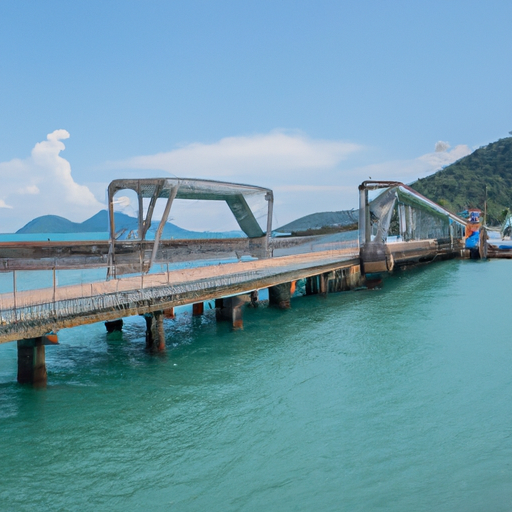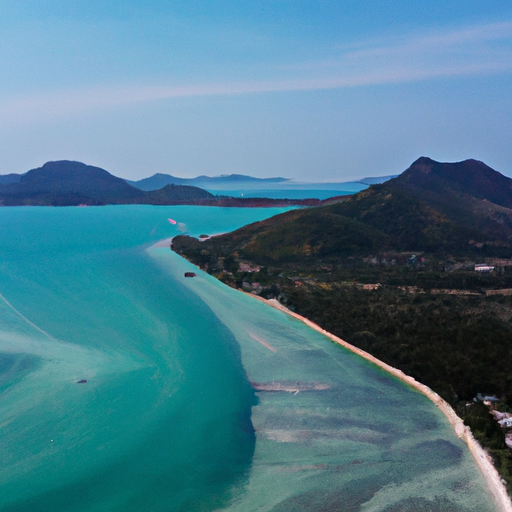Understanding Koh Samui Weather: An Overview of the Island’s Climate
Welcome to the tropical paradise of Koh Samui, where the sun-kissed beaches and lush landscapes await you. Before you pack your bags and head to this stunning island, it’s essential to understand the weather patterns that shape your experience.
What to Expect:
Koh Samui enjoys a tropical climate characterized by two main seasons: the dry season and the wet season. The weather here is influenced by the monsoon winds, which bring heavy rainfall during certain months.
Temperature and Humidity:
Temperatures in Koh Samui typically range from 25°C to 35°C throughout the year. The humidity levels can be high, especially during the wet season, so be prepared for some sticky weather.
Rainfall:
The island experiences the most rainfall from September to December, with November being the wettest month. During this time, you can expect short but intense downpours that provide relief from the heat.
Wind Patterns:
The monsoon winds play a significant role in Koh Samui’s weather. From May to October, the southwest monsoon brings rain and rough seas to the island. In contrast, the northeast monsoon from November to March ushers in drier and cooler weather.
Best Time to Visit:
If you prefer sunny skies and calm seas, the best time to visit Koh Samui is from February to April when the weather is dry and pleasant. However, if you don’t mind occasional showers and lush greenery, the wet season can also offer a unique experience.
By understanding Koh Samui’s weather patterns, you can plan your trip accordingly and make the most of your time on this beautiful island. Stay tuned for more insights on Koh Samui’s seasons, monthly weather breakdown, and tips for navigating the monsoon season.

Koh Samui Seasons: A Detailed Breakdown and What to Expect
Welcome to the tropical paradise of Koh Samui! One of the key factors that can greatly influence your experience on this stunning island is its seasons. Understanding the different seasons in Koh Samui will help you plan your trip effectively and make the most of your time in this beautiful destination.
Dry Season
The dry season in Koh Samui typically runs from December to February. During this time, you can expect clear skies, plenty of sunshine, and low humidity levels. This is considered the peak tourist season, so expect higher prices and more crowds. It’s the perfect time for sunbathing, water activities, and exploring the island’s attractions.
Hot Season
From March to August, Koh Samui experiences its hot season. Temperatures can soar during these months, reaching their peak in April and May. While the weather is hot and humid, this period is ideal for diving and snorkeling due to excellent underwater visibility. Be sure to stay hydrated and seek shade during the hottest parts of the day.
Green Season
The green season, also known as the rainy season, occurs from September to November. During this time, Koh Samui receives the most rainfall, often in short, heavy bursts. While the rain can be intense, it usually doesn’t last all day, leaving plenty of time for activities. The lush greenery that follows the rain showers adds a magical touch to the island’s landscapes.
Shoulder Seasons
The transitional months of April, September, and October are considered shoulder seasons in Koh Samui. These periods offer a mix of good weather and fewer crowds, making them ideal for travelers looking to avoid peak season prices while still enjoying favorable conditions.
By understanding the different seasons in Koh Samui, you can choose the best time to visit based on your preferences and interests. Whether you seek sunny days for beach lounging or lush landscapes for nature exploration, Koh Samui has something to offer throughout the year.
Month-by-Month Weather in Koh Samui: A Comprehensive Guide
Planning a trip to Koh Samui and wondering what the weather will be like during your visit? Let’s dive into a detailed breakdown of the month-by-month weather patterns on this beautiful island paradise.
January
January in Koh Samui is characterized by mild temperatures, low humidity, and minimal rainfall. It’s an excellent time to visit if you prefer cooler weather and want to avoid the crowds.
February
February sees a slight increase in temperatures, with sunny days and pleasant evenings. This month is ideal for outdoor activities like beach hopping and exploring the island.
March
March marks the transition to the hot season in Koh Samui. Expect warm days, clear skies, and a perfect opportunity to soak up the sun on the island’s stunning beaches.
April
April is one of the hottest months in Koh Samui, with temperatures reaching their peak. It’s a great time for water sports and enjoying the vibrant nightlife that the island has to offer.
May
May signals the start of the rainy season in Koh Samui. While you may encounter brief showers, the island’s lush greenery comes to life during this time, creating a picturesque setting.
June
June experiences increased rainfall, but the showers are usually short-lived. It’s a quieter time to visit the island, perfect for those seeking a more laid-back vacation.
July
July continues the rainy season in Koh Samui, with occasional heavy downpours. Despite the rain, there are still plenty of indoor activities and cultural experiences to enjoy on the island.
August
August sees intermittent rain showers, but the weather remains warm and humid. It’s a good time to explore Koh Samui’s temples and indulge in traditional Thai cuisine.
September
September is one of the wettest months in Koh Samui, so be prepared for frequent rain showers. However, the island’s natural beauty shines through, making it a unique time to visit.
October
October marks the end of the rainy season, with clearer skies and decreasing rainfall. It’s a great month for outdoor adventures and exploring Koh Samui’s waterfalls and hiking trails.
November
November brings cooler temperatures and lower humidity levels to Koh Samui. It’s an excellent time for sightseeing and enjoying the island’s attractions without the peak season crowds.
December
December is a popular month to visit Koh Samui, with pleasant weather and festive vibes. It’s a great time to relax on the beaches and partake in holiday celebrations on the island.
Whether you’re planning a beach getaway, an adventure-filled trip, or a cultural exploration, understanding Koh Samui’s month-by-month weather patterns can help you make the most of your visit to this tropical paradise.
Navigating the Koh Samui Monsoon Season: Tips and Precautions
When planning a trip to Koh Samui, it’s essential to be aware of the monsoon season that affects the island. The monsoon season in Koh Samui typically runs from October to December, bringing heavy rainfall and increased humidity. While this might deter some travelers, with proper preparation and knowledge, you can still enjoy your time on the island during this period.
Understanding the Koh Samui Monsoon Season
The monsoon season in Koh Samui is characterized by frequent rain showers, overcast skies, and occasional thunderstorms. The rainfall during this time can be intense, leading to flooding in some areas. However, it’s important to note that the monsoon season doesn’t mean non-stop rain throughout the day. There are still plenty of sunny intervals, and the rain showers are often short-lived.
Tips for Traveling During the Monsoon Season
- Pack Accordingly: Make sure to pack light, quick-drying clothing and waterproof gear to stay comfortable during sudden downpours.
- Plan Indoor Activities: Have a list of indoor attractions, such as museums or cooking classes, to enjoy during rainy days.
- Stay Informed: Keep an eye on weather forecasts and plan your outdoor activities around the predicted rain patterns.
- Stay Safe: Be cautious of slippery surfaces and potential flooding, especially when exploring outdoor areas.
Precautions to Take During the Monsoon Season
While the monsoon season can add a unique charm to your Koh Samui experience, it’s essential to take some precautions to ensure your safety and well-being:
- Stay Hydrated: The increased humidity during the monsoon season can be draining, so make sure to drink plenty of water.
- Protect Your Electronics: Use waterproof cases or bags to protect your electronics from water damage.
- Watch Out for Mosquitoes: The rainy season can lead to an increase in mosquito activity, so use insect repellent to avoid bites.
- Check Travel Advisories: Stay informed about any travel advisories or warnings related to the monsoon season to adjust your plans accordingly.
By being prepared and taking necessary precautions, you can still have a memorable and enjoyable time exploring Koh Samui during the monsoon season. Embrace the tropical showers, enjoy the lush greenery, and take advantage of fewer crowds at popular attractions.
Determining the Best Time to Visit Koh Samui: Maximizing Your Island Experience
Planning a trip to Koh Samui and wondering when the best time to visit this tropical paradise is? Well, you’re in luck! Understanding the island’s weather patterns can help you make the most of your vacation. Let’s dive into the details to ensure you have a fantastic experience on this stunning island.
Peak Season vs. Off-Season
When it comes to visiting Koh Samui, it’s essential to consider the difference between peak season and off-season. The peak season, which runs from December to February, offers dry and sunny weather, making it ideal for beach activities and exploring the island. However, this period tends to be more crowded and expensive.
On the other hand, the off-season, from September to November, may experience some rainfall, but it also means fewer tourists and more budget-friendly options. If you prefer a quieter atmosphere and don’t mind occasional showers, the off-season could be the perfect time for your visit.
Shoulder Seasons: March to August
The shoulder seasons, from March to August, offer a balance between good weather and fewer crowds. During these months, you can enjoy pleasant temperatures, minimal rainfall, and a more relaxed vibe on the island. It’s a great time to explore Koh Samui without the hustle and bustle of peak season.
Events and Festivals
When planning your trip to Koh Samui, consider the various events and festivals that take place throughout the year. From the lively Songkran (Thai New Year) celebrations in April to the vibrant Loy Krathong festival in November, experiencing these cultural events can add a unique touch to your vacation.
Outdoor Activities
Depending on your interests, the best time to visit Koh Samui may vary. If you’re into water sports and beach activities, the dry season from December to February is ideal. On the other hand, if you prefer exploring lush greenery and waterfalls, the rainy season from September to November can offer a different perspective of the island’s beauty.
Final Thoughts
Ultimately, the best time to visit Koh Samui depends on your preferences and what you aim to experience during your trip. Whether you choose to embrace the vibrant atmosphere of peak season or enjoy a more laid-back vacation during the off-season, Koh Samui has something to offer year-round. By considering the weather patterns, events, and activities that align with your interests, you can maximize your island experience and create unforgettable memories in this tropical paradise.



